Struggling to keep your garden lush during Australia’s hot, dry spells? You’re not alone. Many homeowners face the challenge of maintaining a vibrant outdoor space amid unpredictable rainfall and soaring temperatures. But don’t worry – creating a drought-tolerant garden can be both practical and beautiful.
By incorporating hardy plants, effective mulching techniques, and smart lawn alternatives, you can transform your garden into a resilient oasis that thrives with minimal water.
From selecting drought-resistant herbs and groundcovers to employing strategic mulching, these ideas will help you conserve water while ensuring your garden remains a stunning feature of your home. Dive in to discover how you can make your garden both eco-friendly and effortlessly gorgeous.
Understanding Drought Tolerant Gardens
The Concept and Benefits

Drought-tolerant gardens use plants that thrive with minimal water. These gardens suit Australia’s dry climate perfectly. By reducing water usage, you save on water bills and help the environment. Additionally, drought-tolerant plants, including grasses and shrubs, often require less maintenance.
Strategic plant selection leads to a water-efficient garden that remains lush year-round. Hardy species like succulents, native grasses, and aromatic herbs flourish with little water. Mulching further preserves soil moisture, cuts down on weeds, and prevents erosion.
Key Challenges in Australia
Water scarcity poses a significant challenge for Australian gardeners. Drought conditions make maintaining traditional lawns and gardens tough. Choosing the right plants is crucial for combating dry spells. Without careful selection, plants easily wither and die.
Besides plant selection, soil quality significantly impacts plant health. Australian soils often lack organic matter, which affects water retention. Enhancing soil with compost can improve its water-holding capacity. Also, mulching before the warm season ensures soil stays moist longer, supporting plant health. Choosing prime plants for clay gardens is essential for thriving landscapes.
Choosing the Right Plants
Native Australian Plants for Dry Conditions
Choosing native plants is vital for a drought-tolerant garden. These plants have adapted to Australia’s tough climate. Examples are Kangaroo Paw, Grevillea, and Eucalyptus. They need less water and provide a habitat for local wildlife.
Shrubs and Perennials That Thrive in Heat
Select shrubs and perennials that can handle heat. Good choices include Oleander, Rosemary, Lavender, and Bottlebrush. These plants stay vibrant under the sun and add colour to your garden. Group them by water needs for better maintenance.
Optimal Trees for Drought Conditions
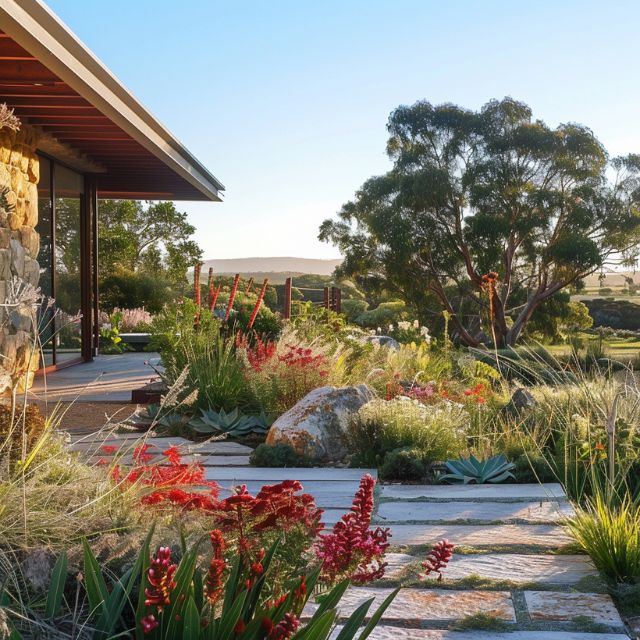
For trees, pick species that can endure dry spells. Some excellent options are the Australian Wattle, Crepe Myrtle, and Jacaranda. They offer shade and keep the environment cooler. Plant them strategically to maximise benefits.
Soil and Water Management
Improving Soil for Drought Resistance
Healthy soil can retain moisture better. Adding organic matter like compost or well-rotted manure improves soil structure. It enhances water-holding capacity and nutrient availability.
Focus on soil aeration to prevent compaction. Aerating the soil allows roots to access water more efficiently. Use mulching to protect the soil surface from erosion.
Efficient Water Use Strategies
Water conservation is key in drought-tolerant gardening. Consider reducing lawn areas to minimise water usage. Replace lawns with ground covers, gravel, or mulch that need little to no watering.
Watering plants deeply yet infrequently encourages deep root growth. This makes plants more resilient during dry periods. Overwatering can harm plants by promoting shallow root systems.
Mulching Techniques
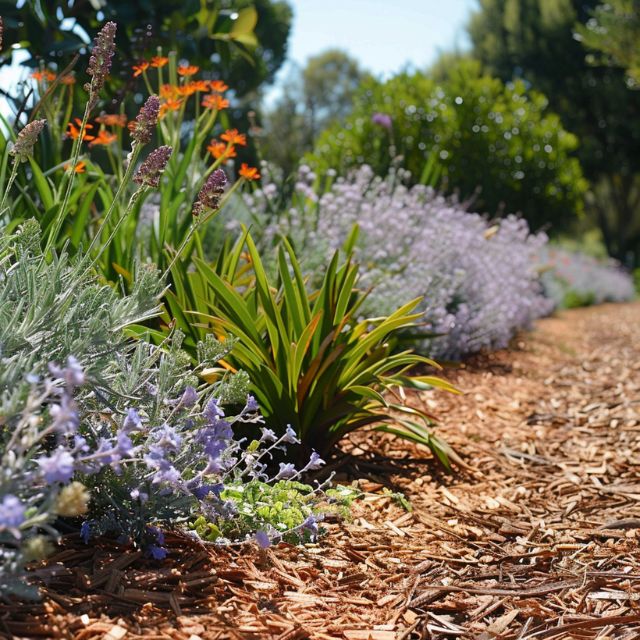
Mulching helps retain soil moisture and suppress weeds. Use materials like wood chips, pine bark, straw, or gravel around plants. These materials reduce water loss through evaporation.
Mulch also helps prevent soil erosion. Heavy rainfall can cause soil particles to wash away, but mulch acts as a protective layer. It absorbs the impact of raindrops and stabilises soil structure.
Lawn Alternatives and Care
Drought Tolerant Lawn Options
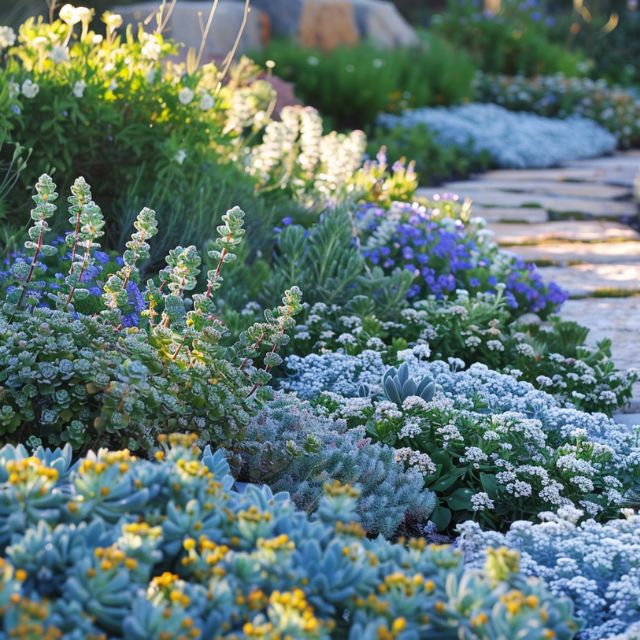
Traditional grass lawns can struggle in the Australian climate. Consider alternatives that thrive in dry conditions. Ground covers like blue chalk sticks, sedums, and clover are excellent choices. These Native Australian garden flora options require less water and maintenance compared to traditional lawns.
Drought-tolerant herbs serve as another viable option. Herbs such as rosemary, sage, thyme, oregano, and tarragon not only look good but also provide culinary benefits. Rockeries and succulent gardens can add aesthetic appeal and are highly resilient to drought.
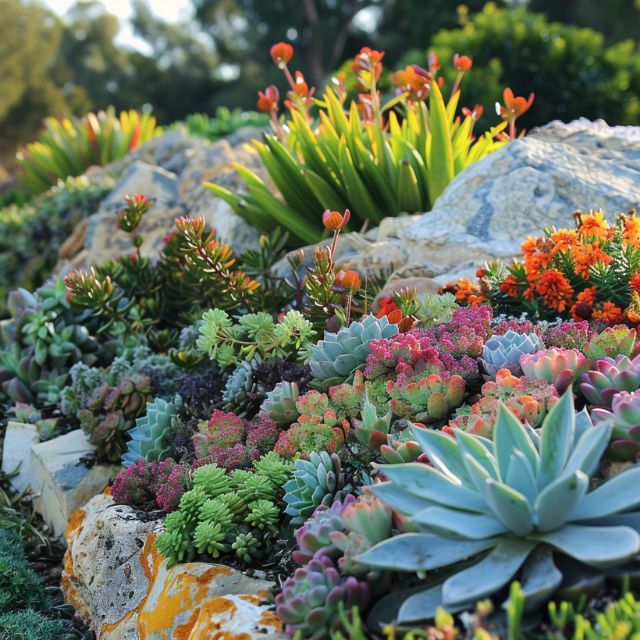
Artificial lawns are also increasingly popular. These lawns remain green year-round and eliminate the need for watering.
Maintenance Tips for Reduced Water Usage
To maintain your lawn during drought, follow specific techniques. Aerate your lawn to prevent soil compaction and improve water infiltration. Apply wetting agents before summer to avoid dry spots.
Mowing higher supports root growth and reduces stress on the grass. Use a mulching lawnmower, leaving clippings to protect the thatch and retain moisture. Avoid fertilising in summer; do it in autumn using slow-release fertilisers.
Using herbicides can harm your lawn during dry periods. Opt for organic methods to control weeds. These measures will help you keep a healthy lawn with minimal water.
Practical Garden Design Tips
Creating Shade and Shelter
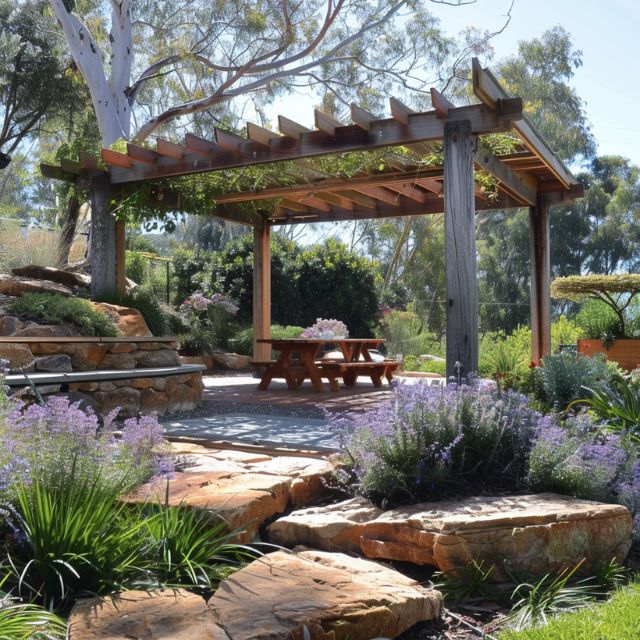
Introduce tall trees and shade cloth installations to create shaded areas. Build structures like gazebos or pergolas for more permanent solutions. Retractable canopies or awnings offer flexibility in managing sunlight exposure. These additions reduce soil moisture evaporation, helping plants thrive.
Garden Layout for Minimised Water Usage

Design garden zones based on water needs. Group plants with similar water requirements together. Place drought-tolerant plants like sedums and blue chalk sticks in sunny spots. Use rockeries and succulents as visual elements that require minimal water. Create pathways to direct foot traffic, preventing soil compaction and helping the soil retain water.
Up next:
